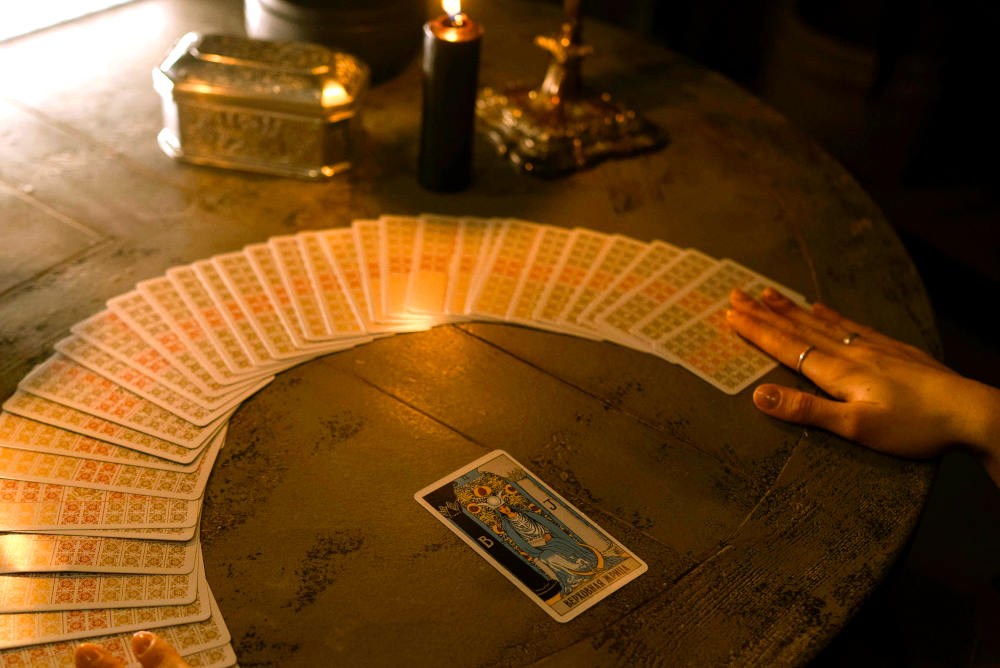
Tarotkarten sind oft von Mysterien und Aberglauben umgeben. Eine der häufigsten – und am häufigsten missverstandenen – Fragen zum Tarot ist: Können Tarotkarten Geister herbeirufen? Manche glauben, Tarot öffne ein Tor zur Geisterwelt und lade Wesen ein, sowohl gute als auch böse. Andere argumentieren, Tarot sei lediglich ein psychologisches oder symbolisches Werkzeug ohne spirituelle Konsequenzen.
Dieser Artikel beleuchtet beide Seiten der Debatte und untersucht die Ursprünge des Tarots, seine Verwendung in spirituellen Praktiken, religiöse Perspektiven, psychologische Erkenntnisse und die Erfahrungen von Tarot-Praktizierenden aus der Praxis. Am Ende werden Sie ein tieferes Verständnis dafür haben, ob Tarotkarten uns tatsächlich mit Geistern verbinden – oder ob dieser Glaube eher Mythos als Realität ist.
Panaprium ist unabhängig und wird vom Leser unterstützt. Wenn Sie über unseren Link etwas kaufen, erhalten wir möglicherweise eine Provision. Wenn Sie können, unterstützen Sie uns bitte monatlich. Die Einrichtung dauert weniger als eine Minute und Sie werden jeden Monat einen großen Beitrag leisten. Danke schön!
1. Ursprünge des Tarot und seine beabsichtigte Verwendung
Ursprünglich war Tarot nicht dazu gedacht, Kontakt mit Geistern aufzunehmen.
Tarotkarten stammen aus dem Europa des 15. Jahrhunderts, wo sie als Kartenspiel namens Tarocchi ihren Anfang nahmen. Diese frühen Kartenspiele dienten hauptsächlich der Unterhaltung. Erst im 18. und 19. Jahrhundert wurde Tarot dank Mystikern wie Antoine Court de Gébelin und später dem Hermetic Order of the Golden Dawn mit dem Okkulten in Verbindung gebracht.
Diese esoterischen Gruppen interpretierten Tarot als symbolisches System zum Verständnis des Universums und des Selbst. Sie glaubten, die Karten könnten verborgene Wahrheiten enthüllen, nicht unbedingt durch den Kontakt mit Geistern, sondern durch die Anbindung an universelle Energien, Archetypen oder das Unterbewusstsein.
Kernpunkt: Tarot wurde nicht geschaffen, um Geister zu beschwören oder mit ihnen Kontakt aufzunehmen. Seine spirituellen Assoziationen kamen erst später auf, und selbst damals ging es eher um inneres Wissen als um äußere Wesenheiten.
2. Sind beim Tarotkartenlegen Geister im Spiel?
Die meisten Tarotkartenleser behaupten heute nicht, beim Benutzen der Karten mit Geistern Kontakt aufzunehmen.
Modernes Tarot wird hauptsächlich für folgende Zwecke verwendet:
-
Selbstreflexion und persönliche Einsicht
-
Meditation und Achtsamkeit
-
Entscheidungsfindung und Klarheit
-
Symbolisches Geschichtenerzählen
-
Psychologische Erkundung
Manche Leser, insbesondere solche, die sich als spirituell oder intuitiv bezeichnen, glauben möglicherweise, Führung von einer höheren Quelle zu erhalten – etwa von Geistführern, Vorfahren, Engeln oder dem höheren Selbst des Nutzers. Dies wird jedoch oft eher als eine Form intuitiver Verbindung denn als buchstäbliche Beschwörung von Geistern angesehen.
Dennoch gibt es Praktizierende – insbesondere in bestimmten spirituellen oder medialen Kreisen –, die Tarot als Teil der spirituellen Kommunikation nutzen. Sie kombinieren Tarot möglicherweise mit Praktiken wie Channeling, automatischem Schreiben oder Séancen. Für sie ist Tarot ein Werkzeug, um Botschaften aus dem Jenseits zu interpretieren.
Kann Tarot also Geister herbeirufen? Nicht von selbst. Aber in den Händen von jemandem, der aktiv versucht, mit Geistern zu kommunizieren, kann es als Teil dieses Prozesses verwendet werden.
3. Medialität vs. Tarotkartenlegen
Um den Unterschied zu verstehen, ist es hilfreich, das Tarotlesen vom Medium zu trennen.
-
Beim Tarotlesen geht es um die Interpretation symbolischer Bilder und Archetypen, um Erkenntnisse oder Ratschläge zu gewinnen. Es handelt sich oft um einen Dialog zwischen dem Leser und dem Klienten (oder sich selbst), der auf Intuition oder Selbstbeobachtung basiert.
-
Medialität beinhaltet die direkte Kommunikation mit Geistern – wie Verstorbenen, Geistführern oder anderen Wesenheiten. Sie kann das Hören von Stimmen, das Sehen von Visionen oder den Empfang von Botschaften beinhalten, die an den Klienten weitergeleitet werden.
Manche Medien nutzen Tarotkarten, um ihre Intuition zu fokussieren, aber nicht alle Tarotkartenleger sind Medien. Tatsächlich sind es die meisten nicht. Tarot beschwört nicht automatisch Geister herauf, genauso wenig wie ein Tagebuch Geister heraufbeschwört, wenn man darin schreibt.
4. Religiöse und kulturelle Überzeugungen über Geister und Tarot
Viele religiöse Traditionen warnen vor Tarot, da es angeblich eine Tür zur spirituellen Welt – und möglicherweise zu gefährlichen Wesen – öffnet.
a) Christentum
Konservative christliche Gruppen zitieren oft Bibelstellen wie Deuteronomium 18:10–12, die vor Wahrsagerei, Spiritismus und der Kommunikation mit Toten warnen. Sie glauben, dass Tarot dämonische Mächte anlockt, auch unbeabsichtigt.
Manche Pastoren lehren, dass Tarot – selbst zum Spaß oder zur Selbsthilfe – böse Geister anziehen kann, da es zu den verbotenen spirituellen Praktiken gehört. Aus dieser Sicht ist Tarot nicht neutral. Es gilt als spirituell riskant.
b. Islam
Der Islam verbietet grundsätzlich Wahrsagerei und Weissagung, einschließlich Praktiken wie Tarot. Die Ausübung dieser Praktiken gilt als haram (verboten) und könnte die Seele für unerwünschte spirituelle Einflüsse öffnen.
c. Indigene und afrodiasporische Glaubensvorstellungen
Einige spirituelle Traditionen wie Vodou, Santería oder traditionelle afrikanische Religionen glauben zwar an die Kommunikation mit Geistern – doch Tarot ist dabei meist nicht das wichtigste Instrument. Diese Kulturen verfügen möglicherweise über andere Wahrsagemethoden, wie etwa Knochen, Muscheln oder Ahnenforschung.
In einigen Fällen wurde Tarot mit spirituellen Praktiken vermischt, allerdings mit absichtlichem rituellem Schutz und klarer Unterscheidung zwischen Wahrsagerei und Geisterbeschwörung.
5. Die Rolle von Absicht und Glaube
In spirituellen Angelegenheiten spielt die Absicht eine wichtige Rolle.
Wenn jemand glaubt, dass Tarot eine Möglichkeit ist, mit Geistern in Kontakt zu treten – und es aktiv zu diesem Zweck nutzt –, kann er sich spirituellen Erfahrungen öffnen. Das bedeutet nicht unbedingt, dass Geister objektiv anwesend sind. Aber sein Glaube und seine Konzentration können eine starke psychologische oder energetische Umgebung schaffen, die sich real anfühlt.
Umgekehrt gilt: Wenn jemand Tarot als symbolisches oder psychologisches Werkzeug betrachtet und nicht an Geister glaubt, wird sich das wahrscheinlich auch in seinen Erfahrungen widerspiegeln. Für diese Person ist Tarot introspektiv, nicht übernatürlich.
Einige spirituelle Lehrer argumentieren, dass die Energie, die man ins Tarot einbringt, beeinflusst, was man daraus erhält. Wenn man mit Angst an die Sache herangeht, kann man angstbedingte Ergebnisse erzielen. Wenn man mit Neugier und Respekt an die Sache herangeht, kann die Erfahrung erhellend und sicher sein.
6. Können Geister eine Tarot-Lesung kapern?
Manche Menschen befürchten, dass Geister – insbesondere negative – eine Tarot-Lesung kapern könnten.
Im Internet und in spirituellen Gemeinschaften kursieren Geschichten über Menschen, die nach dem Tarotspiel seltsame Phänomene erlebten: flackerndes Licht, Albträume, unheimliche Empfindungen oder sogar das Gefühl, beobachtet zu werden. Diese Berichte sind zwar überzeugend, aber größtenteils anekdotisch und lassen sich oft wie folgt erklären:
-
Suggestion oder psychologisches Priming
-
Angst- oder angstbasierte Reaktionen
-
Schlafstörungen
-
Falsch zugeschriebene Zufälle
Dennoch wird in Traditionen, die an Geister glauben, oft zum Schutz geraten. Viele Leser setzen Grenzen durch:
-
Vor dem Lesen Gebete oder Affirmationen sprechen
-
Verwendung von Schutzkristallen (wie schwarzem Turmalin)
-
Reinigen ihres Decks mit Rauch oder Salz
-
Anrufung wohlwollender Kräfte oder Führer
Diese Rituale sind nicht für jeden notwendig – aber für diejenigen, die an den Kontakt mit Geistern glauben, dienen sie als energetischer Schutz.
7. Psychologische Erklärungen
Aus psychologischer Sicht wird Tarot oft als ein Werkzeug zum Zugang zum Unterbewusstsein beschrieben.
Carl Jung, der berühmte Schweizer Psychologe, war fasziniert von Symbolik, Archetypen und dem Konzept der Synchronizität – bedeutungsvollen Zufällen, die verborgene Wahrheiten enthüllen. Er benutzte zwar kein Tarot, doch seine Ideen haben die moderne Tarotpraxis stark beeinflusst.
Psychologen glauben im Allgemeinen nicht, dass Tarotkarten Geister bringen. Stattdessen erklären sie seltsame Erlebnisse als Folge von:
-
Suggestibilität
-
Projektion unbewusster Gedanken
-
Emotionale Übertragung
-
Stress oder Vorstellungskraft
Tarot funktioniert dieser Ansicht nach, weil es den Menschen hilft, über ihr Leben nachzudenken – und nicht, weil Geister die Karten bewegen.
8. Paranormale und New-Age-Glaubensvorstellungen
In New-Age-Kreisen variieren die Vorstellungen über Geister stark. Einige Anhänger glauben an:
-
Geistführer , die Schutz und Einsicht bieten
-
Vorfahren , die Weisheit anbieten
-
Energiewesen oder interdimensionale Entitäten
In diesen Gemeinschaften wird Tarot manchmal als Mittel zur Kontaktaufnahme mit solchen Wesen verwendet – normalerweise jedoch auf kontrollierte, respektvolle Weise.
Es ist erwähnenswert, dass selbst in der spirituellen Gemeinschaft großer Wert auf Urteilsvermögen gelegt wird. Nur weil jemand Tarot benutzt, heißt das nicht, dass er jeden Geist einlädt. Verantwortungsbewusste Praktizierende setzen klare Absichten, Grenzen und Schutzmaßnahmen.
9. Erfahrungen aus der realen Welt: Begegnen Menschen tatsächlich Geistern?
Im Internet finden sich Tausende von persönlichen Geschichten von Menschen, die behaupten, beim Tarotkartenlegen Geistern begegnet zu sein. Manche berichten, sie hätten Botschaften von verstorbenen Angehörigen erhalten. Andere beschreiben plötzliche Schüttelfrostgefühle, unerklärliche Geräusche oder lebhafte Träume nach einer Tarotkarte.
Diese Erfahrungen sind jedoch subjektiv und variieren stark. Auf jede Geschichte von Geisterkontakten kommen viele weitere von Menschen, die jahrzehntelang Tarot benutzt haben, ohne dass sie jemals paranormale Ereignisse erlebt hätten.
Ob diese Erfahrungen real, eingebildet oder symbolisch sind, hängt von Ihrer Weltanschauung ab. Für Gläubige sind sie ein Beweis dafür, dass Tarot Welten verbinden kann. Für Skeptiker sind sie psychologische oder emotionale Reaktionen.
Fazit: Es hängt von Ihnen ab
Können Tarotkarten Geister bringen?
Die Antwort lautet: Es hängt davon ab, was Sie glauben und wie Sie es nutzen.
-
Wenn Sie Tarot als spirituelles Werkzeug betrachten und versuchen, damit Kontakt mit Geistern aufzunehmen, können Sie Erfahrungen machen, die sich wie eine Kommunikation mit Geistern anfühlen.
-
Wenn Sie Tarot als Spiegel Ihrer Gedanken, als Symbol für Ihre Reise oder als kreative Übung betrachten, ist es unwahrscheinlich, dass Sie etwas Paranormales erleben.
-
Wenn Sie sich dem Tarot mit Angst oder ohne Grenzen nähern, fühlen Sie sich möglicherweise verunsichert – nicht aufgrund von Geistern, sondern aufgrund Ihrer Einstellung.
Tarot ist nicht unbedingt ein Tor zur spirituellen Welt. Aber spirituell und psychologisch gesehen kann es ein Tor zu tieferen Teilen Ihres Selbst sein – und diese Reise kann sich mystisch anfühlen.
Wie jedes Werkzeug spiegelt Tarot die Energie, Absicht und den Glauben des Anwenders wider. Bei weisem Einsatz kann es eine kraftvolle Quelle der Erkenntnis und Inspiration sein. Bei unvorsichtigem oder ängstlichem Einsatz kann es Verwirrung oder Angst auslösen.
Letztendlich ist die Frage nicht nur, ob Tarot Geister herbeirufen kann, sondern ob Sie das möchten .
War dieser Artikel hilfreich für Sie? Bitte teilen Sie uns in den Kommentaren unten mit, was Ihnen gefallen oder nicht gefallen hat.
About the Author: Alex Assoune
Wogegen Wir Kämpfen
Weltweit-Konzerne produzieren in den ärmsten Ländern im Übermaß billige Produkte.
Fabriken mit Sweatshop-ähnlichen Bedingungen, die die Arbeiter unterbezahlt.
Medienkonglomerate, die unethische, nicht nachhaltige Produkte bewerben.
Schlechte Akteure fördern durch unbewusstes Verhalten den übermäßigen Konsum.
- - - -
Zum Glück haben wir unsere Unterstützer, darunter auch Sie.
Panaprium wird von Lesern wie Ihnen finanziert, die sich unserer Mission anschließen möchten, die Welt völlig umweltfreundlich zu gestalten.
Wenn Sie können, unterstützen Sie uns bitte monatlich. Die Einrichtung dauert weniger als eine Minute und Sie werden jeden Monat einen großen Beitrag leisten. Danke schön.































0 Kommentare